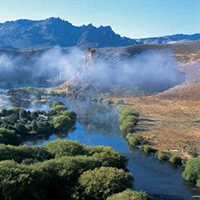Spatial variation of picoplankton communities along a cascade reservoir system in Patagonia, Argentina

Submitted: 29 April 2021
Accepted: 23 July 2021
Published: 3 September 2021
Accepted: 23 July 2021
Abstract Views: 782
PDF: 197
Supplementary 1: 211
Supplementary 2: 193
HTML: 16
Supplementary 1: 211
Supplementary 2: 193
HTML: 16
Publisher's note
All claims expressed in this article are solely those of the authors and do not necessarily represent those of their affiliated organizations, or those of the publisher, the editors and the reviewers. Any product that may be evaluated in this article or claim that may be made by its manufacturer is not guaranteed or endorsed by the publisher.
All claims expressed in this article are solely those of the authors and do not necessarily represent those of their affiliated organizations, or those of the publisher, the editors and the reviewers. Any product that may be evaluated in this article or claim that may be made by its manufacturer is not guaranteed or endorsed by the publisher.
Similar Articles
- Maciej Błażejewski, Jarosław Król, Tomasz Kakareko, Katarzyna Mierzejewska, Piotr Hliwa, Daily and seasonal dynamics of littoral zone fish communities in the lowland Włocławek Reservoir (central Poland), with a special emphasis on alien invasive gobies , Journal of Limnology: Vol. 81 (2022)
- Cristian Scapozza, Nicola Patocchi, Lake Maggiore: geomorphological genesis, lake-level evolution, and present and future ecosystems importance , Journal of Limnology: Vol. 81 No. s2 (2022): Effects of water level management on lake littorals and downstream river areas
- Faye L. Merrix-Jones, Stephen J. Thackeray, Stephen J. Ormerod, A global analysis of zooplankton in natural and artificial fresh waters , Journal of Limnology: Vol. 72 No. 1 (2013)
- Gemma Burgazzi, Alex Laini, Erica Racchetti, Pierluigi Viaroli, Mesohabitat mosaic in lowland braided rivers: Short-term variability of macroinvertebrate metacommunities , Journal of Limnology: Vol. 76 No. s1 (2017): Aquatic biomonitoring: Lessons from the past, challenges for the future
- Ewa A. Dembowska, Paweł Napiórkowski, A case study of the planktonic communities in two hydrologically different oxbow lakes, Vistula River, Central Poland , Journal of Limnology: Vol. 74 No. 2 (2015)
- Caterina Maria Antognazza, Silvia Quadroni, Isabella Vanetti, Vanessa De Santis, Giuseppe Crosa, Serena Zaccara, The increasing spread of the European barbel in the Italian large lowland rivers is threatening the native species , Journal of Limnology: Vol. 81 No. s2 (2022): Effects of water level management on lake littorals and downstream river areas
- Mihir R. Kulkarni, Kalpana Pai, The freshwater diaptomid copepod fauna (Crustacea: Copepoda: Diaptomidae) of the Western Ghats of Maharashtra with notes on distribution, species richness and ecology , Journal of Limnology: Vol. 75 No. 1 (2016)
- Finn A. Viehberg, Reinhard Pienitz, Trends in Ostracoda and Cladocera distribution and water chemistry in subarctic Canada: Churchill (Manitoba) lakes and ponds revisited , Journal of Limnology: Vol. 76 No. 3 (2017)
- Anton WILLE, Bettina SONNTAG, Birgit SATTLER, Roland PSENNER, Abundance, biomass and size structure of the microbial assemblage in the high mountain lake Gossenköllesee (Tyrol, Austria) during the ice-free period , Journal of Limnology: Vol. 58 No. 2 (1999)
- Elzbieta Dumnicka, Kamil Najberek, Valeria Lencioni, Oligochaete distribution in alpine freshwaters: not a mere question of altitude , Journal of Limnology: Vol. 82 (2023)
<< < 9 10 11 12 13 14 15 16 17 18 > >>
You may also start an advanced similarity search for this article.

 https://doi.org/10.4081/jlimnol.2021.2027
https://doi.org/10.4081/jlimnol.2021.2027





